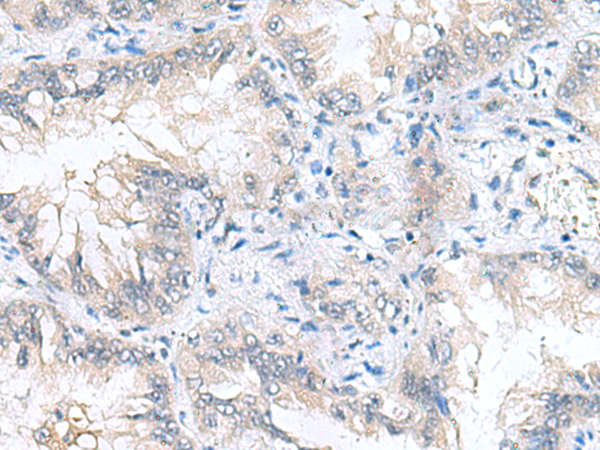
| WB | 咨询技术 | Human,Mouse,Rat |
| IF | 咨询技术 | Human,Mouse,Rat |
| IHC | 1/50-1/200 | Human,Mouse,Rat |
| ICC | 技术咨询 | Human,Mouse,Rat |
| FCM | 咨询技术 | Human,Mouse,Rat |
| Elisa | 1/5000-1/10000 | Human,Mouse,Rat |
| Aliases | NEZHA; PPP1R80; KIAA1543 |
| Host/Isotype | Rabbit IgG |
| Antibody Type | Primary antibody |
| Storage | Store at 4°C short term. Aliquot and store at -20°C long term. Avoid freeze/thaw cycles. |
| Species Reactivity | Human, Mouse |
| Immunogen | Synthetic peptide of human CAMSAP3 |
| Formulation | Purified antibody in PBS with 0.05% sodium azide and 50% glycerol. |
+ +
以下是关于CAMSAP3抗体的3篇参考文献及其简要摘要:
---
1. **文献名称**:*CAMSAP3 regulates neuronal polarity through the noncentrosomal microtubule organization*
**作者**:Tanaka N. et al.
**摘要**:该研究利用CAMSAP3特异性抗体,通过免疫荧光和免疫印迹技术,揭示了CAMSAP3在小鼠神经元发育中调控非中心体微管排列的作用,并发现其缺失导致神经元极性异常。
---
2. **文献名称**:*Structural basis of CAMSAP3 recognition by the E3 ligase TRIM36*
**作者**:Zhu Z. et al.
**摘要**:作者开发了一种高亲和力CAMSAP3抗体,用于共聚焦显微镜和Co-IP实验,阐明了TRIM36通过泛素化修饰调控CAMSAP3稳定性的分子机制,为微管相关蛋白的降解途径提供新见解。
---
3. **文献名称**:*CAMSAP3 deletion enhances cell migration via altered microtubule dynamics*
**作者**:Wang Y. et al.
**摘要**:该研究通过CRISPR/Cas9敲除CAMSAP3并结合特异性抗体检测,证明CAMSAP3缺失促进癌细胞迁移,其机制与微管动态不稳定性增加及细胞前沿微管网络重构相关。
---
以上文献均使用CAMSAP3抗体进行蛋白定位、功能或互作研究,涵盖神经发育、蛋白降解和癌症领域。如需更多文献或实验细节,可进一步提供关键词或研究背景。
CAMSAP3 (Calmodulin-Regulated Spectrin-Associated Protein 3) is a member of the CAMSAP/Patronin family involved in organizing microtubule networks by stabilizing their minus ends. It plays critical roles in establishing cell polarity, maintaining cytoskeletal architecture, and regulating intracellular transport. CAMSAP3 antibodies are immunological tools designed to detect and study this protein in various experimental settings, such as immunofluorescence, Western blotting, or immunoprecipitation. These antibodies are typically generated in hosts like rabbits or mice using immunogenic peptides or recombinant protein fragments corresponding to conserved regions of human CAMSAP3.
Research using CAMSAP3 antibodies has revealed its localization to microtubule-organizing centers and its involvement in epithelial cell polarization, mitotic spindle orientation, and neuronal development. Dysregulation of CAMSAP3 is linked to pathologies, including cancer metastasis and neurodevelopmental disorders. Validated CAMSAP3 antibodies help distinguish its unique isoforms and post-translational modifications, aiding mechanistic studies. Commercial antibodies often undergo specificity verification via knockout cell lines or siRNA knockdown. As CAMSAP3 interacts with key regulators like KIF3A and LL5β, its antibodies are valuable for exploring microtubule dynamics in cellular models (e.g., HeLa, MDCK) and disease contexts. Proper validation remains essential due to potential cross-reactivity with other CAMSAP family members.
×